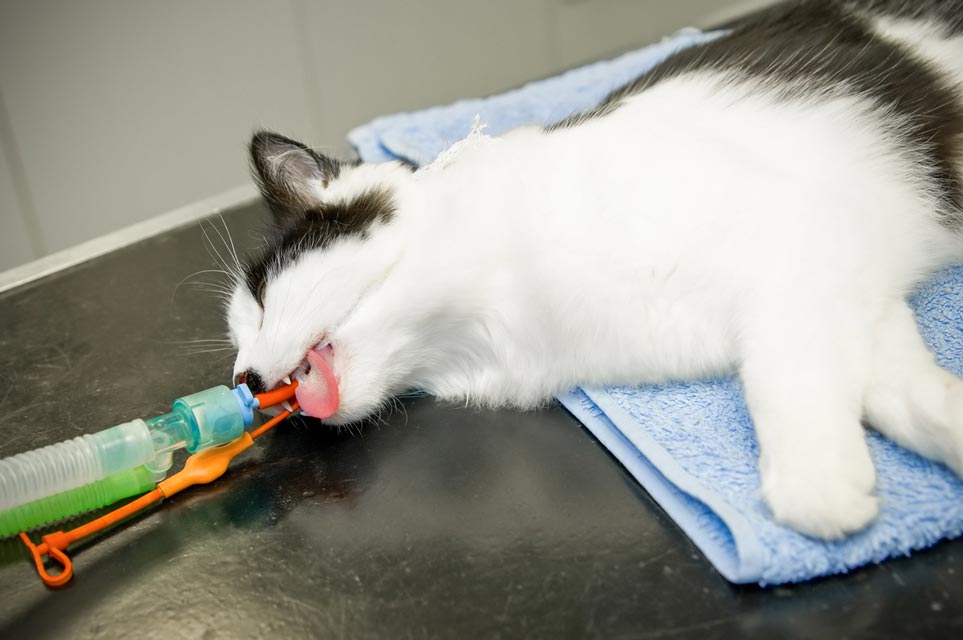Anesthesia in Cats

If your cat needs to go under anesthesia for a procedure, you might be feeling concerned. Be sure to ask your veterinarian any specific questions you have, and we've also collected some basic information for you here.
When Does a Cat Need Anesthesia?
Anesthesia is medication that removes the sensation of pain. It might be local, which is injected into a small area of the body so something can be done there. Anesthesia could also be general, which induces unconsciousness and general nerve depression so a procedure can be done. Below are some various situations in which anesthesia might be necessary for a cat.
Local anesthetic might be required when:
- A small wound or sore needs to be cleaned and worked with.
- A procedure needs to be done on a certain body area but the cat is a poor risk for general anesthesia.
- When a particularly painful procedure is done, a local anesthetic may be combined with a general for increased pain control. An example of this is a local dental block for a tooth removal.
General anesthetic might be required when:
- An abdominal, intrathoracic, or bone repair surgery is to be done on the cat.
- Most cases of laceration repair in cats require general anesthesia.
- The cat is too aggressive to accomplish a test or procedure, even though it can be done on some cats without anesthesia.
- The cat needs to be perfectly still for a procedure such as an MRI or CT scan.
What Are the Risks of Anesthesia for Cats?
Whenever any medication, including anesthetic, is introduced into a cat's body, the potential for adverse reactions exists. The main risks of anesthesia in cats include:
- Allergic reactions that range from mild swelling at the site of injection to life-threatening anaphylaxis.
- Vomiting occurs fairly regularly as a cat is waking up from anesthesia. Because they still might not have full control of their epiglottis at that time, if they ate prior to anesthesia and they vomit up food, they might breathe the vomitus into their lungs, resulting in serious aspiration pneumonia.
- Organ failure may occur secondary to anesthesia. Sometimes this is because the pet's organs were already functioning sub-optimally, but other times, it is idiopathic, meaning we don't know the reason it occurs.
- Severe seizures can occasionally be triggered by anesthesia.
- Kidney damage can occur during anesthesia if the pet gets too cold or the blood pressure gets too low for too long.
- Undiagnosed, hidden heart conditions can be stressed by anesthesia, resulting in cardiac arrest.
How Can Anesthesia Be Made Safer for Your Cat?
Some things that can increase the safety of general anesthesia in cats include:
- Pre-surgical blood work that can reveal if the kidney or liver function is already decreased.
- Pre-surgical temperature and periodic temperature readings done during anesthesia can alert the staff if the cat is getting too cold, and steps can be taken to keep the pet warm.
- Monitoring devices that alert the staff if blood pressure, heart rate, respiratory rate, or oxygen rate get too low can be helpful because steps can be taken to counteract these effects.
- A human monitor assigned to constantly watch the pet and any machine monitors that are used can greatly increase the safety of a cat's anesthetic time.
- Using the least amount of the anesthetic agent that is necessary to maintain the desired effect can increase its safety. Often, injectable agents that are short-acting are given to induce anesthesia, and then a tube is placed down the cat's windpipe so he can be given gas anesthetic and oxygen to keep him asleep. Gas anesthesia can be adjusted easily and quickly to keep the pet asleep while minimizing negative side effects.
- An IV catheter placed before the procedure increases its safety because it provides a port through which medications can be given quickly and easily to help counteract any negative reactions the cat might have.
- Keeping fluids pumping through an IV catheter into the cat's body during anesthesia can help the cat maintain better blood pressure levels and hydration, which can aid in protecting the kidneys from anesthesia's potential negative effects.
Most of the time, anesthesia in cats goes well and doesn't result in any lasting negative effects.
You May Also Like These Articles:
X-Rays in Cats: What They Can Tell Your Vet
Common Blood Tests Done on Cats
MRI in Cats: What Is It and Why Might Your Cat Need It?
Fine Needle Aspiration: FNA in Cats
Causes of Unexplained Weight Loss in Cats
Notice: Ask-a-Vet is an affiliated service for those who wish to speak with a veterinary professional about their pet's specific condition. Initially, a bot will ask questions to determine the general nature of your concern. Then, you will be transferred to a human. There is a charge for the service if you choose to connect to a veterinarian. Ask-a-Vet is not manned by the staff or owners of CatHealth.com, and the advice given should not delay or replace a visit to your veterinarian.





